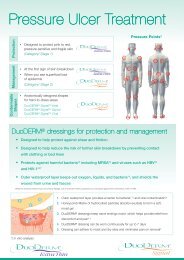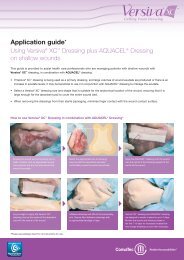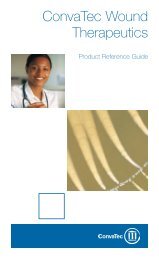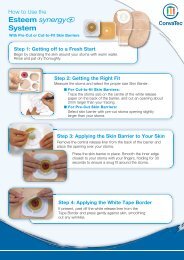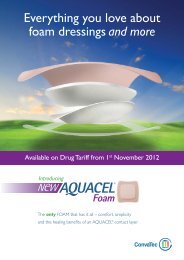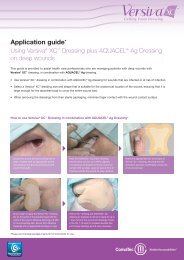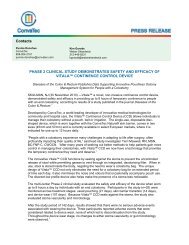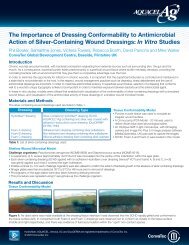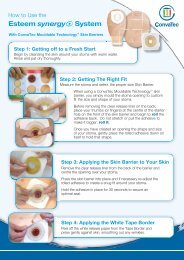AQUACEL® Ag Made Easy - ConvaTec
AQUACEL® Ag Made Easy - ConvaTec
AQUACEL® Ag Made Easy - ConvaTec
Create successful ePaper yourself
Turn your PDF publications into a flip-book with our unique Google optimized e-Paper software.
PRODUCTS FOR PRACTICE<br />
AQUACEL ® <strong>Ag</strong><br />
Dressings<br />
made<br />
easy<br />
Box 2 What is Hydrofiber ® Technology?<br />
Hydrofiber ® Technology is a patented technology by which fine fibers of high-purity cellulose are<br />
carboxymethylated in a very controlled way. Carboxymethylation of the cellulose alters its structure<br />
to allow it to better absorb and retain fluid. The fibers are meshed together by needle-bonding. This<br />
process uses fine barbed needles pushed through the fibers to entangle them to form a stable fleece<br />
layer. The layer can then be cut to form dressing pads or ribbons.<br />
Locking in fluid<br />
Dressings that contain Hydrofiber ® Technology rapidly absorb fluid 5 . Once fluid is absorbed, the fibers<br />
swell to form a clear, soft, cohesive gel that is able to retain structural integrity (Figure 1) and maintain a<br />
moist wound environment to support healing. As the fibers swell, the fluid and its contents, eg bacteria,<br />
inflammatory cells and enzymes, are trapped and held within the dressing 6,7 . In addition, the gelling<br />
action prevents lateral spread of fluid through the dressing, reducing the risk of periwound maceration 8-10 .<br />
Micro-contouring<br />
Dressings that contain Hydrofiber ® Technology have the ability to closely contour (micro-contour)<br />
to the wound bed when a gel forms 1 (Figure 2). This means that there is no or very little dead space<br />
between the wound and the dressing 7 where fluid may accumulate and bacteria may proliferate (as<br />
demonstrated by in vitro testing).<br />
Responding to wound conditions<br />
Dressings that contain Hydrofiber ® Technology are able to respond to wound conditions by<br />
forming a cohesive gel. The gelled dressing maintains a moist wound environment, aids autolytic<br />
debridement and supports the healing process. At dressing removal, the gelled dressing does not<br />
damage delicate granulation tissue or the healthy tissue surrounding wounds.<br />
Why is ionic silver important?<br />
High silver content or the total amount<br />
of silver made available by a dressing<br />
does not relate directly to greater<br />
antimicrobial activity 8 . This is because<br />
silver exists in several chemical forms.<br />
Silver metal (<strong>Ag</strong>) can only become<br />
effective as an antimicrobial agent when<br />
it transforms into silver ions (<strong>Ag</strong> + ).<br />
response to exudate levels, ie ‘on demand’ 3 .<br />
The amount of ionic silver available is<br />
limited by the maximum amount of silver<br />
ions that can get into solution, ie if exudate<br />
levels increase or ionic silver is consumed<br />
by antimicrobial action, the concentration<br />
of silver ions in the exudate drops and the<br />
dressing will release more to re-establish<br />
the maximum solution concentration 3 .<br />
Because the silver ions are readily<br />
available and easily dissociated from the<br />
strands of Hydrofiber ® Technology, the<br />
dressings do not need to contain large<br />
amounts of silver to be able to produce<br />
sufficient concentrations of silver ions ‘on<br />
demand’ for antimicrobial action 3,4 .<br />
What is the evidence?<br />
Laboratory studies of AQUACEL ® <strong>Ag</strong><br />
dressing have demonstrated:<br />
n broad spectrum antimicrobial<br />
activity 3<br />
n sustained antimicrobial activity (up<br />
3, 13<br />
to 14 days<br />
Additional clinical studies of AQUACEL ®<br />
<strong>Ag</strong> dressings have demonstrated:<br />
n high absorption and fluid<br />
retention 9<br />
n reduced pain during wear and at<br />
dressing removal 19-21<br />
n easy application and removal 21 .<br />
Clinical evaluation of AQUACEL ® <strong>Ag</strong><br />
dressings has been undertaken in a<br />
wide range of wound types, including<br />
chronic leg ulcers 22 , diabetic foot<br />
ulcers 23 , partial-thickness burns 21,24,25 ,<br />
surgical wounds 26 and wound cavities 27 .<br />
Silver ions damage bacterial cell walls and<br />
interfere with DNA synthesis. Silver ions also<br />
denature proteins and enzymes, and inhibit<br />
protein synthesis, killing the bacterium 16 .<br />
This multi-targeted mechanism of action<br />
means that ionic silver has a far lower<br />
propensity to induce bacterial resistance<br />
than classic antibiotics 17 .<br />
Figure 1 Scanning electron micrographs (SEM) of Hydrofiber® dressing (Courtesy of <strong>ConvaTec</strong>)<br />
A<br />
B<br />
AQUACEL ® <strong>Ag</strong> dressings contain silver only<br />
in the ionic form (<strong>Ag</strong> + ). The dressings act<br />
as a reservoir of silver ions by continually<br />
supplying a concentration that has effective<br />
antimicrobial action 3,4 , while avoiding higher<br />
concentrations that may cause transient skin<br />
staining as seen during in vitro testing 18 .<br />
AQUACEL ® <strong>Ag</strong> dressings make ionic<br />
silver available in a controlled manner in<br />
C<br />
A. Dry Hydrofiber® dressing before<br />
application to a wound<br />
B. Individual fibers expand up to ten-fold 15 as<br />
they form a cohesive gelled structure<br />
C. As the fibers swell they lock in harmful<br />
components such as bacteria. In this SEM<br />
picture Pseudomonas aeruginosa is shown<br />
to be trapped within the gelling fibers<br />
2<br />
MADE EASY AQUACEL.indd 4 08/04/2011 09:26





